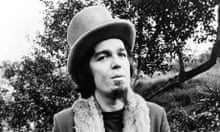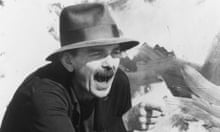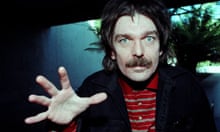Don Van Vliet, better known as Captain Beefheart, who has died aged 69 of complications from multiple sclerosis, was one of the most influential American musicians of the 1960s and 1970s. His status was always cult rather than commercial, and for most of his career he was broke.
Yet he remained a hero to most of the musical avant garde: the Grateful Dead, Jefferson Airplane and the Mothers of Invention in America; Roxy Music, Hawkwind, Jethro Tull, Family and Edgar Broughton in Britain. He was one of John Peel's favourite artists, and the DJ did much to promote Beefheart by playing his records when no other radio programme would touch them.
In 1964 Beefheart formed the Magic Band, the first of many lineups under the name. They sounded pretty discordant, but due to Beefheart's mesmeric presence, a four-and-a-half octave vocal range, his eccentric ability with lyrics and his inexplicable one-liners to interviewers, the band was unforgettable.
Beefheart once described his thing to an uncomprehending radio interviewer as "music to dematerialise the catatonia". His style was rhythm and blues-based but completely unorthodox in its approach to structure, rhythm and key. Magic Band musicians had names such as Winged Eel Fingerling, Zoot Horn Rollo, the Mascara Snake and Rockette Morton. They wore a ragbag of cloaks and the Captain wore a hat, usually a topper, which became his trademark.
Van Vliet was born in Glendale, California, an only child who showed artistic talent. He claimed he was producing respected sculpture at the age of five. When he was 13, his family moved to the Mojave desert, an atmosphere that was to have an enormous influence on him, and particularly his painting, and a place where he lived on and off all his life.
In 1959 he was offered a place at Antelope Valley junior college as an art major, but instead he hung out at home with his schoolfriend Frank Zappa, listening to old r'n'b records and planning various projects. One was dreamed up sitting stoned in a car ("Not Zappa," recalled Beefheart, "Frank never turned on") in the desert in 1962, to shoot a film called Captain Beefheart Meets the Grunt People. The film was never made, but the name stuck.
From their early teens, Beefheart and Zappa developed a love-hate relationship which became lifelong, mainly based on Beefheart's resentment of Zappa's success. Despite briefly moving to Cucamonga in California in the early 1960s to be with Zappa, intending to form a band called the Soots, Beefheart remained in the desert while Frank, an astute businessman, moved to Los Angeles and founded the Mothers of Invention.
Beefheart's early albums remain the most original: Safe as Milk (produced by Bob Krasnow and Richard Perry, 1967); Strictly Personal (completed in a week, produced by Krasnow, 1968) and two albums for Zappa's Straight label: Trout Mask Replica (1969) and Lick My Decals Off, Baby (1970). For Trout Mask Replica, Beefheart locked the Magic Band in a house in Woodland Hills for eight months, continually rehearsing the songs. Virtually broke, they often had nothing but bread to eat, but when they finally got into the studio they recorded the double album in four and a half hours.
Although they admired him, other musicians found Beefheart exasperating. The guitarist Ry Cooder played on the first album and was due to appear at the Monterey festival in 1967 with the band, but left in a temper after Beefheart had a panic attack during rehearsal and walked off the back of the stage, landing on top of his manager.
It was Beefheart's stubborn refusal to conform that invariably lost him the big bucks. And he was not indifferent to money. He loved fast cars and owned variously a Hudson, Corvette and Jaguar, drank brandy alexanders, and always wore the best shoes he could afford.
In 1974 Beefheart was signed to Virgin Records. Richard Branson also desperately wanted to sign Zappa, but it was during one of Beefheart's hate-Frank periods. Despite being warned never to mention the name, virtually the first words Branson uttered to Beefheart were about how great it would be when he had also got Zappa on to the label. It was a fateful and uneasy start. Yet when, as invariably happened with Beefheart, the relationship between artist and record company soured, it was Zappa who rescued Beefheart and took him on tour. Beefheart responded by filling a series of huge sketchbooks with angry drawings of Zappa.
Despite having no formal training in art, Beefheart drew and painted throughout his music career. His first exhibition was in Liverpool at the Bluecoat Gallery in 1972, while he was touring in Britain. He executed 15 black and white paintings in situ. In 1982, on the advice of the New York art dealer Michael Werner that he would never be taken seriously as a painter unless he gave up music, Beefheart turned to art and gained a reasonable reputation.
He married his wife Jan in 1970. She cared for him through his debilitating multiple sclerosis until the end.




